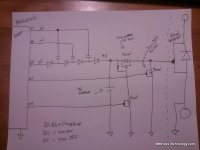liveforphysics
100 TW
I'm really curious how the linear reg works to boost with no inductor. A link to that cool part to check out would nice if you have the time to share it my friend.
I know how boot-strapping with a cap, diode, resistor, and something switching on an off works to climb voltage for driving a high-side FET, but it doesn't work if it can't tap that higher voltage side as well to enable it to climb it's supply high. This is how the high-side FETs are switched on an ebike controller as you know of course, and also the reason all current-control is handled on the low-side switching phase only with the top-side's comparatively weak power available for switching happening only at the commutation rate rather than the fast switching PWM required for current control that the low-side provides.
I know you can make a voltage doubler which switches in and out of being in series or parallel with charge storage caps rapidly to make higher voltage using no inductor, but it's typically very power hungry to use this method if you're working on sipping uA for your power budget, and the inductor type can be quite a bit higher efficiency topology as far as I understand it, but I'm no expert, more like an arm-chair putz talking about topology things I don't understand deeply enough to be talking about them, but hopefully you can occasionally pull a good idea out of the mess once in a while.
I know how boot-strapping with a cap, diode, resistor, and something switching on an off works to climb voltage for driving a high-side FET, but it doesn't work if it can't tap that higher voltage side as well to enable it to climb it's supply high. This is how the high-side FETs are switched on an ebike controller as you know of course, and also the reason all current-control is handled on the low-side switching phase only with the top-side's comparatively weak power available for switching happening only at the commutation rate rather than the fast switching PWM required for current control that the low-side provides.
I know you can make a voltage doubler which switches in and out of being in series or parallel with charge storage caps rapidly to make higher voltage using no inductor, but it's typically very power hungry to use this method if you're working on sipping uA for your power budget, and the inductor type can be quite a bit higher efficiency topology as far as I understand it, but I'm no expert, more like an arm-chair putz talking about topology things I don't understand deeply enough to be talking about them, but hopefully you can occasionally pull a good idea out of the mess once in a while.









